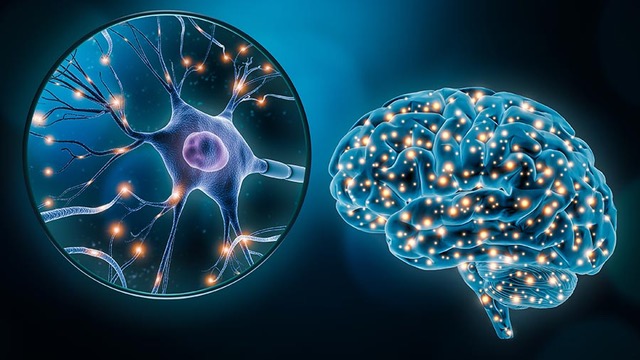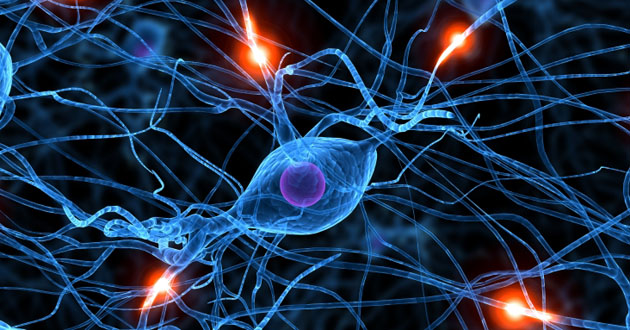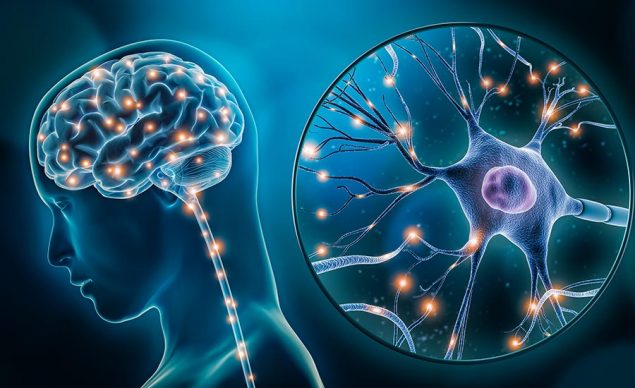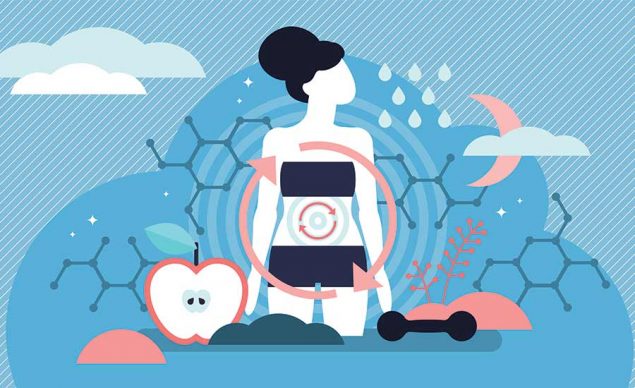Related Resources
Only three-pounds heavy, your brain is your body’s command and processing center.
It is where your body sends the stimuli it receives through the senses — sight, sound, smell, touch — for interpretation, and where your body gets its orders to move, speak and perform other activities.
To deliver its instructions as well as to collect information from all parts of your body, your brain needs help.
It relies on its messengers, a.k.a. neurons.
What is a neuron? How does it work? Let’s enter the large, intricate web of your brain’s messengers!

What Is A Neuron?
A neuron is a messenger cell and the primary building block of your central and peripheral nervous systems.
A neuron’s role is to transmit sensory messages to the brain and then pass on its instructions throughout your body to their intended recipient.
Say you see an adorable puppy.
Your eyes register its cute face, your ears register its puppy barks, your legs might register its enthusiastic tail brushing up against you, and your nose may register its freshly applied dog shampoo.
All of these are just stimuli — data if you will — that your senses pick up and send to your brain for processing using neurons.
Once your brain understands that an enthusiastic, freshly bathed puppy is beside you, it may send a fuzzy feeling to your heart and a “must-pet-this-puppy” control to your hands. And, before you know it, you’re snuggling the fluff ball!
How Many Neurons Does A Brain Contain?
Since your brain works 24/7 — yes, even while you’re sleeping! — and there are a lot of stimuli to process and commands to issue, it needs a big network of neurons to rely on.
Although this number may seem unbelievable, your brain houses around 86 billions of neurons, each of them playing a part in carrying messages to various parts of your body to ensure it functions properly.
Besides voluntary movements, your neurons also make sure the automatic actions inside your body run smoothly, such as your heart beating, lungs breathing and your other organs doing their jobs effectively.
How Long Are Neurons?
The length of neurons varies from small to quite long!
Since neurons must reach every single corner of your body, some of them need to be very long to do their job. In fact, certain types of neurons represent the longest cells in your body!
The longest neuron in your body spans from the bottom of your spine to your big toe, and is around 3 feet (1 meter) long!
Of course, not all axons are three feet long. They can be as short as 0,003 feet!
Are There Neurons In The BioWars Comic?
In BioCosmos, where BioWars stories take place, your neurons are represented by Nero. He is one of the key players in the battle for the BioCosmos, i.e. the universe inside all of us.

Nero and his fellow BioWarriors (the warriors of your immune system) want to keep the BioCosmos peaceful and healthy, but the dangerous microbes continuously attempt to disrupt the peace and hurt their host.
Their clash is the topic of the BioWars comic book, and we invite you to read it to discover how remarkable your body is, explore the power of your immune system and meet the brave soldiers protecting your Bioverse!

How Are Neurons Structured?
Neurons are made up of three parts:
- The cell body or soma
- The dendrites
- The axons
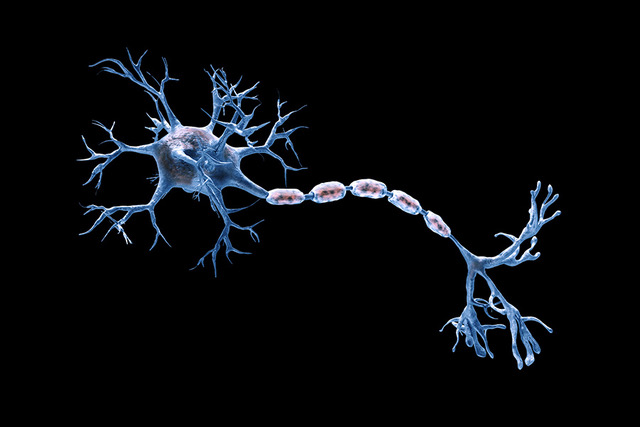
1. The Cell Body
Like other cells in your body, neurons, too, have a nucleus, a membrane that surrounds them and protects them, and organelles, such as cytoplasm and Golgi bodies.
But neurons also have two structures that other cells don’t — dendrites and axons.
The two are attached to the neurons’ membrane.
2. Dendrites
Dendrites, a.k.a., dendrons, are placed on a neuron’s end.
From there, they branch out resembling a tree. However, they always stay close to the nerve cell body.
Dendrites have an important job to do — soak up information from other cells. They contain proteins that allow them not only to receive signals but also to process them and pass them on to the soma!
Dendrites also pack organelles that enable them to change protein density depending on the frequency of the input they receive from other neurons. The dendritic ability to modify protein density as needed prevents some neurological disorders (e.g. epilepsy) from happening.
3. Axons
Axons, or nerve fibers, are like cables that transmit nerve impulses from the nerve cell body to other neurons, gland cells and muscle cells.
They are long, single, and cylinder-like fibers.
Your body contains two types of axons: myelinated and unmyelinated.
Myelinated axons are surrounded by a fat layer of the myelin sheath.
Myelin is a material packed with lipids that insulates axons and it helps them transfer signals to remote destinations fast.
To send signals to several nerve cells at once, axons form side branches, axon collaterals.
Axon collaterals then split into even tinier extensions known as axon terminal branches.
Every terminal contains a synapse, which is a structure that enables neurons to pass on their signals to other cells.
To transmit the signal, neurons secret neurotransmitters into synapses. Neurotransmitters are messenger molecules that carry a neuron’s signal to another neuron, muscle, or a gland.
Remember the neuron that extends from the bottom of your spine to your big toe? That’s actually an axon that stretches that long! After all, this particular axon needs to transmit signals from the spine to your big toe, so this axon’s length comes as no surprise!

How Do Neurons Work?
The work your neurons do goes through several stages.
First, your dendrites get to work. The cell body is up next. And then axons get to do their thing.
Here’s how that looks.
1. What Do Dendrites Do?
Dendrites are the first ones to spur into action.
Picture this.
You’re playing basketball with some friends.
When you want to score, how do you instantly know how strong you should shoot the ball and at what height should your hands be so that the ball falls through the hoop?
This is possible thanks to your neurons.
You perceive information about the size of the ball and your distance from the hoop with your eyes. Using your hands, you can determine the weight of the ball.
Your neurons translate this information into electrical signals.
They pick up electrical signals and pass them through to the cell body.
2. What Do Axons Do?
Axons carry messages.
After nerve impulses pass through the cell body, they go through axons, which act like cables that transfer electricity.
They carry information, i.e. nerve impulses from the cell body to the next cell.
Now, neurons aren’t glued to each other.
Synapses keep them apart, while neurotransmitters connect them one to another!
When one neuron passes a signal to another, your neurotransmitters work at a remarkable speed.
Research shows that neurons can pass anywhere between 5 to 50 messages per second!
And as if that’s not impressive enough, research shows that neurons can carry signals from more than one stimuli at a time!
So, the next time you’re playing basketball, video games or reading your BioWars comic book, you’ll know that millions of neurons are working hard at once to make what you do instantly possible. But that doesn’t necessarily mean you can blame your neurons if you miss the game-winning shot!
Types Of Neurons
Of 86 billion neurons, your body contains thousands of different neuron types.
We’re going to categorize them depending on their function and form.
In terms of function, we can categorize neurons into three main types:
- Afferent neurons
- Efferent neurons
- Interneurons
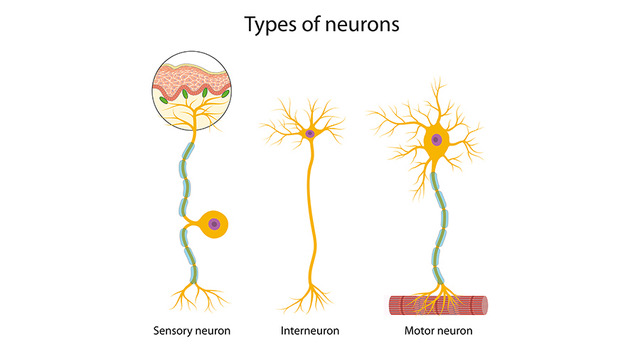
#1: Afferent Neurons
Also known as sensory neurons, these neurons carry signals from your senses to your brain. They help you:
- See
- Hear
- Taste
- Smell
- Feel
Afferent neurons act as receptors that inform your brain of the physical or chemical changes in your environment.
They are precisely what allows you to tell whether something is hot or cold and enjoy the smell of freshly baked cookies.
#2: Efferent Neurons
While similar to afferent neurons in their name, efferent neurons have a completely different function.
Efferent neurons are transmitters that enable your brain and spinal cord to send impulses to your organs, glands and muscles.
They are precisely what enables your body movements — voluntary and involuntary. This is why efferent neurons are also known as motor neurons.
Your body contains two types of efferent neurons:
- Upper motor neurons
- Lower motor neurons
Upper motor neurons transmit signals between your spinal cord and brain.
Lower motor neurons pass signals from your spinal cord to smooth (i.e. involuntary) muscles and skeletal muscles.
By the way, smooth muscles are muscles that don’t have cross stripes like other muscles. You have them in your stomach, for example.
When you eat, food moves along your digestive system thanks to muscle contractions of the smooth muscles in your esophagus, stomach and intestines. These muscle contractions happen because the efferent neurons in your spinal cord send signals to relevant organs.
#3: Interneurons
Interneurons are the unsung heroes of your nervous system, as they enable other neurons to communicate with each other.
They make up about 99% of all neurons in your body.
Interneurons are located in your brain and spinal cord.
As their name suggests, they act as intermediaries between sensory and motor neurons. They connect neurons in your brain with neurons in your spinal cord.
In many ways, interneurons help your brain keep you safe.
For instance, if you place your hand on a hot stove, the afferent neurons in your brain will register the temperature through the nerve endings in your palm and fingers.
Then, the neurons will inform your brain of the impending danger, you’ll feel the pain, and your brain will react by sending signals through efferent neurons, prompting you to remove your hand as quickly as possible.
As you can imagine, these neurons act super fast and they excel at what they do, hence your instant reaction.
Interneurons also participate in some abstract doings of your mind, including the ability to focus and feel emotions.
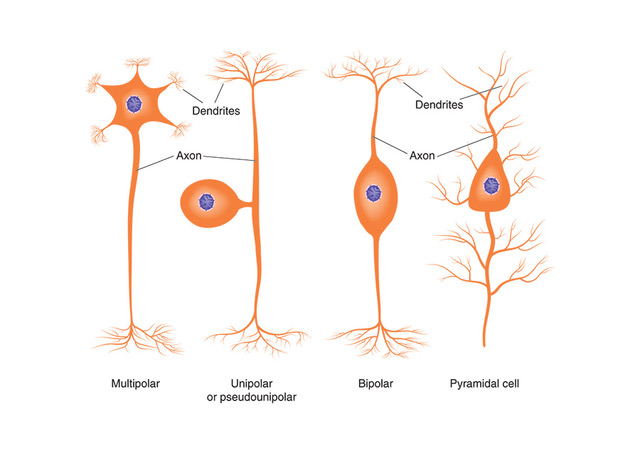
Now, as for the form of neurons, we distinguish five major neuron types:
- Unipolar neurons: The majority of unipolar neurons are sensory neurons. They have one axon. Unipolar neurons are typically located within the skin, internal organs, muscles and joints.
- Multipolar neurons: These guys have one axon and many dendrites that extend from that axon. Motor neurons are usually multipolar neurons.
- Bipolar neurons: This type of neurons have an axon extending on one side and dendrites on the other. The majority of bipolar neurons are sensory neurons.
- Pseudo-unipolar neurons: These neurons have a single axon that splits into two branches. One of them goes to the peripheral nervous system and the other to the spinal cord.
- Pyramidal neurons: This bunch has one axon and several dendrites that form a pyramid shape. Pyramidal neurons are a type of multipolar neurons. They’re located in the cerebral cortex (memory, learning, conscious thoughts), the hippocampus (learning, memory) and the amygdala (emotions).
- Purkinje neurons: These neurons have one axon and many fan-shaped dendrites attached to the soma. They are located in the cerebral cortex and play a big role in movement learning, their control and coordination.
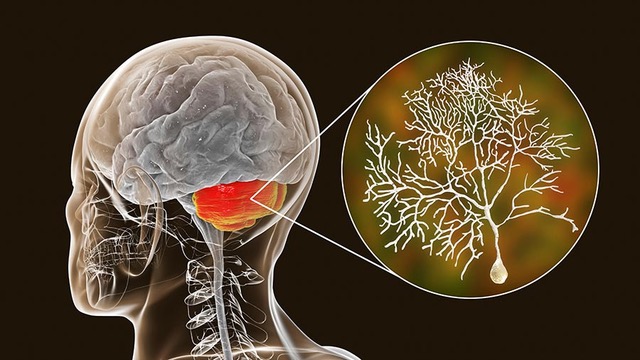
What Are Neurological Disorders?
Neurological disorders are diseases that affect the nervous system.
Aside from the brain and spinal cord, some types of neurological disorders may also affect neurons, causing their early death.
When a person is healthy, their neurons can live super long.
In fact, of all the cells in your body, neurons tend to live the longest. Research shows that neurons may even live forever as long as they have a body to live into.
For the most part, however, your neurons will remain healthy throughout your lifetime.
Although neurons usually live long, they are very fragile.
This means that a heavy blow to the head or body may cause neuronal damage. When the brain suffers a blow, that may kill off neurons in a beat, or it may deprive them of the oxygen, without which they can’t survive.
Aside from physical damage, some neurons may die during migration and differentiation.
Neuronal migration is the process during which neurons travel from the place where they were born (neural stem cells) to where they need to do their job. However, scientists say that only about one-third of all neurons reach their final destination.
When a neuron gets to where it wants to, it grows in size, makes more dendrites and connects with surrounding cells. This phase is called neuronal differentiation.
If neurons die during any of these phases from unnatural reasons, unfortunately, some brain disorders may occur.
Some of the most common types of neurological disorders include:
- Parkinson’s Disease: This is a disease that happens when neurons that produce dopamine, a neurotransmitter that affects your emotions, movements, and pleasure/pain sensations, die off. When that happens, the patient has mobility issues.
- Huntington’s Disease: When a gene mutation occurs and causes neurons to secret too much of a neurotransmitter called glutamate, the excess of that neurotransmitter kills off neurons, and causes people to twist and move their body uncontrollably.
- Alzheimer’s Disease: When proteins begin to build up in and around neurons and cause them to die, that affects patient’s memory and their ability to perform everyday tasks.
- Injuries: Damage caused by strokes or injuries to the spinal cord can block communication between neurons. If that happens, those neurons can continue to live, but they lose the ability to communicate with each other.
Although these serious neurological disorders exist, the good news is that modern medicine has discovered a lot of new ways to help those who suffer from these types of problems.
For example, scientists have discovered that stem cell therapy can help paralyzed patients who suffered an injury to the spinal cord regain control of their movement and start to function on their own.
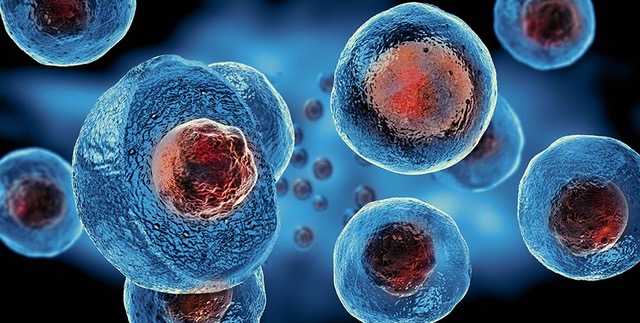
Recap On What Is A Neuron
Neurons are messengers that transmit messages to your brain and carry its instructions throughout your body.
Although they may be the longest-living cells in the body, they are quite delicate, and can be affected by some serious neurological disorders that could affect the quality of one’s life.
The good news is that neurology is advancing at a rapid pace, and soon those disorders might become much less threatening to the neurons’ well-being.

